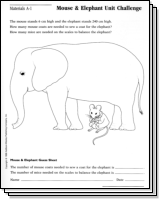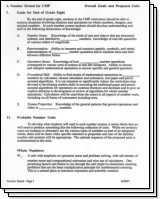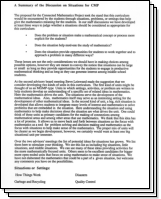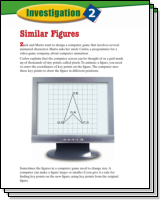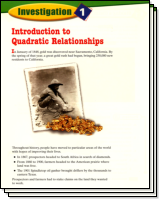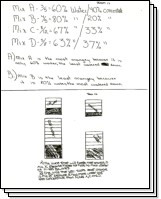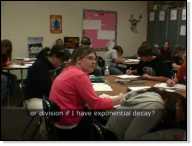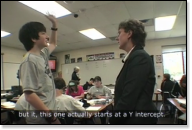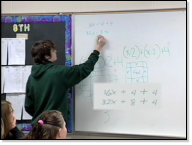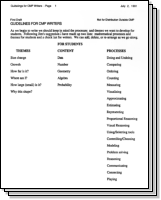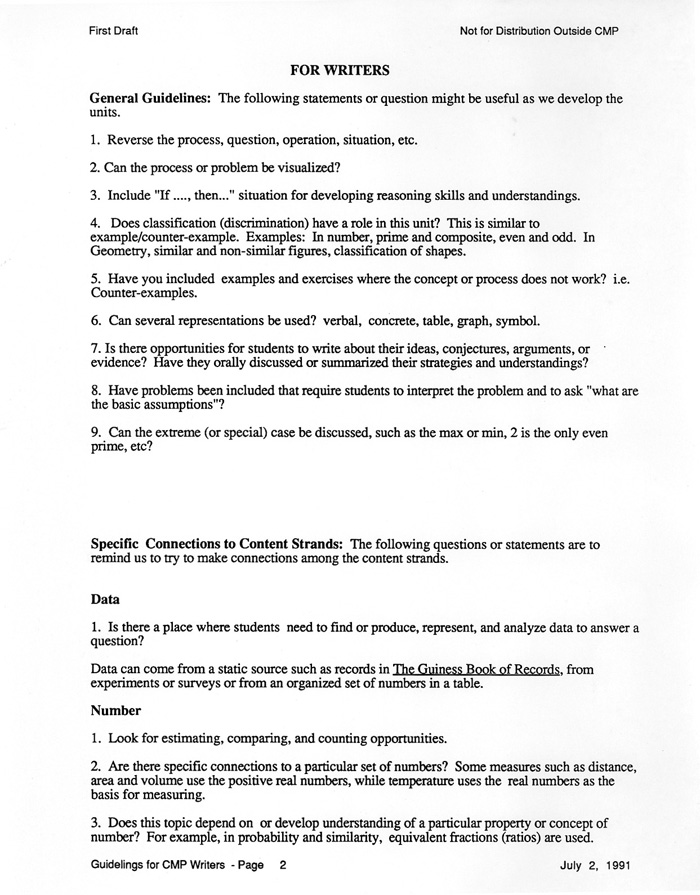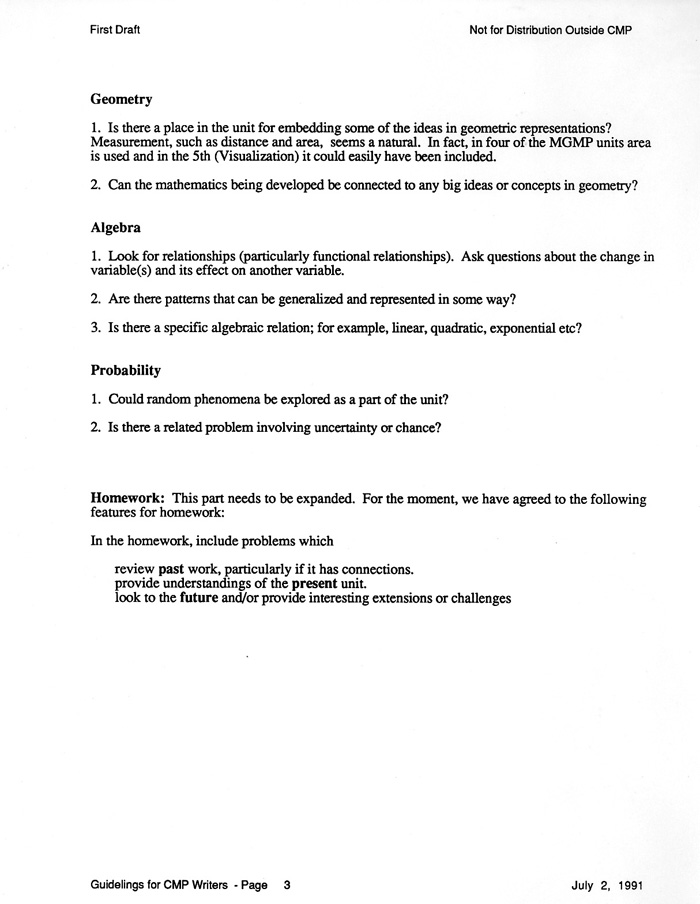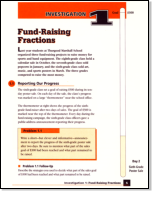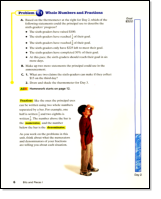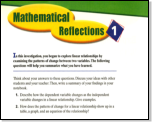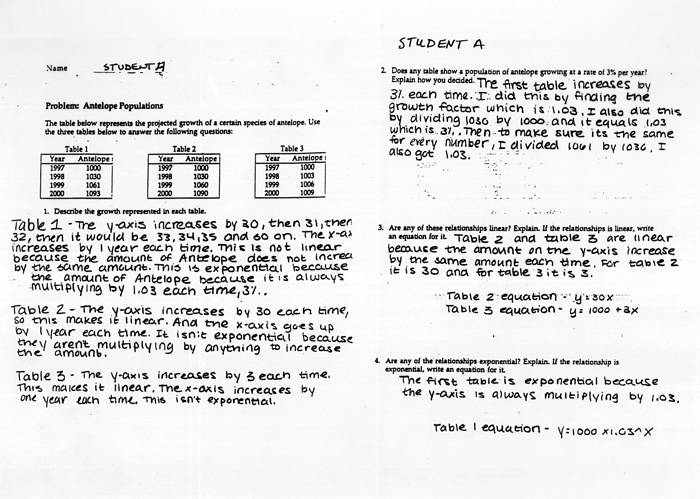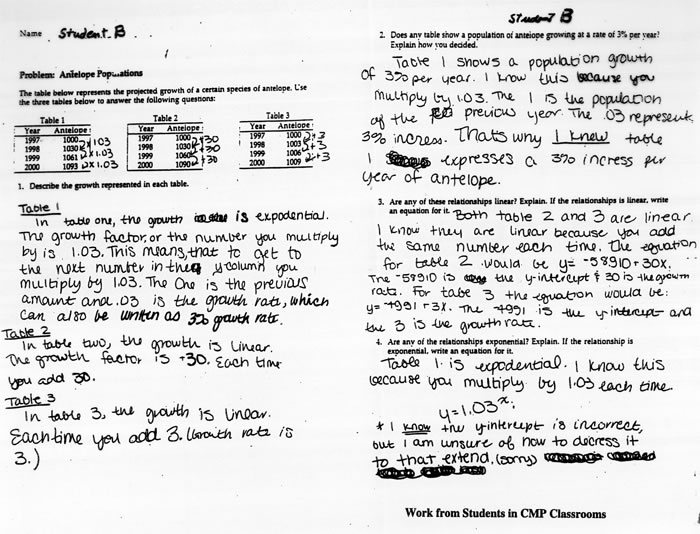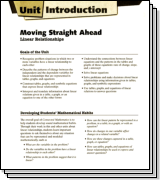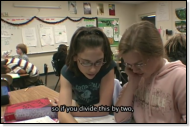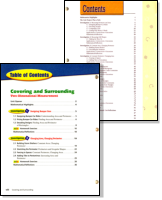In various configurations with our colleagues at Michigan State University, William Fitzgerald and Mary Winter, we received funding for several NSF Teacher Enhancement Grants in the 70’s. This pushed us even further into writing materials to use in our work with professional development to give experienced teachers new ways to engage students with mathematics. We created five units that were published in 1985 for use by teachers to help make a transition from how they typically taught, ’show and practice’, to classrooms that required engagement in mathematical thinking, reasoning, solving, and proving. These units are known as the Middle Grades Mathematics Project (MGMP). Each was focused on an important area of mathematical thinking and each was designed to engage students in big problem situations that were engaging, challenging, and educative [1] (see Figure 1). During this time our focus was on developing experienced teachers’ knowledge of mathematics and their skill in engaging students in making sense of mathematics. It was due to these MGMP materials and their success that our group was asked to make substantial contributions to the development of the Curriculum and Evaluation Standards for School, published by the National Council of Teachers of Mathematics (NCTM, 1989). Lappan chaired the middle school writing group and reviewed the draft standards with teachers in our summer institutes. This document launched a new era of curriculum development in the US and our group was ready to act on our conviction that curriculum materials could make a difference.

A Designer Speaks: Glenda Lappan and Elizabeth Phillips
Michigan State University
Challenges in US Mathematics Education through a Curriculum Developer Lens
Abstract
1The need to improve the teaching and learning of mathematics has been a focus of attention in the US over our entire careers. There have been waves of national interest in mathematics education that have attracted mathematicians and mathematics educators to the work of improving K-12 mathematics education. Today we will focus our remarks in two areas, our own curriculum development work including the story of how we came to engage in and accomplish the work and our comments on the challenges we face in future work to improve mathematics teaching and learning. We expect that many of the challenges we see are also challenges for mathematics education worldwide. First we will share relevant aspects of the work in which our research and development group have engaged for over 35 years. Many of these remarks are based on other papers that we have published about our work. But for this special audience we would like to tell you a bit of our personal stories.
Let us begin by saying that our path to curriculum development is anything but straightforward. We arrived at development work through a circuitous route. The two of us, Glenda and Betty, came together as teachers of those who aspire to be mathematics teachers for K-12 classrooms. We taught mathematics courses designed for intending K-8 teachers and for those who were seeking an undergraduate degree in mathematics. We actually believed that we could build for these important undergraduates the same love and passion that we had for the discipline itself. What’s not fun about working for days on a mathematical proof to see it implode in front of you! We worked to create problem situations that could turn our students on to mathematics and that would help develop their skills, conceptual knowledge, and their mathematical ways of thinking. We found time for these problems in our department’s chosen curriculum by what Hugh Burkhardt calls ‘low cunning’. We gradually replaced a lot of “their” curriculum with different experiences for our students. The thing that kept our activities below the radar screen was that our classes always scored at the top on the department’s uniform final exams.
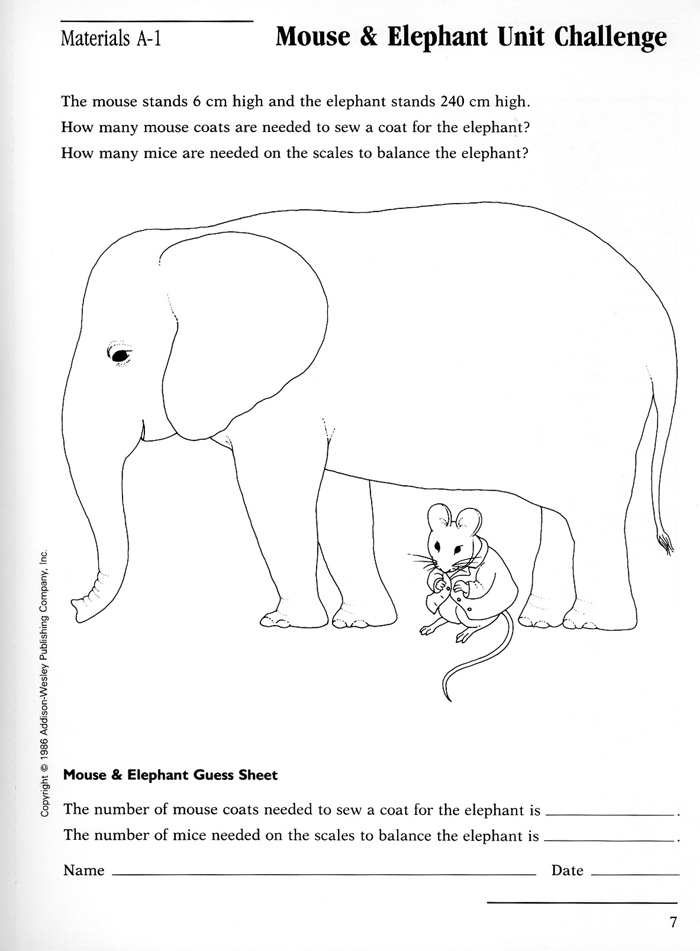

Jerome Bruner, in the 1990 Robert Karplus lecture given at the annual National Science Teachers Association meeting paid a tribute to Karplus who was a theoretical physicist and a leader in the field of science education, generally viewed as the ‘father’ of the science learning cycle (Bruner, 1992, p. 5):
What he knew was that science is not something that exists out there in nature, but that it is a tool in the mind of the knower—teacher and student alike.
Bruner (1992, p. 5) goes on to say:
Getting to know something is an adventure in how to account for a great many things that you encounter in as simple and elegant a way as possible. And there are lots of ways of getting to that point, lots of different ways. And you don’t really ever get there unless you do it, as a learner, on your own terms. … All you can do for a learner enroute to their forming a view of their own view is to aid and abet them on their own voyage. ... in effect, a curriculum is like an animated conversation on a topic that can never be fully defined, although one can set limits upon it. I call it an “animated” conversation not only because one uses animation in the broader sense—props, pictures, texts, films, and even “demonstrations.” Conversation plus show-and-tell plus brooding on it all on one’s own.
While these remarks were made about science, they resonate with the reformulation of curriculum goals for mathematics K-12 happening worldwide. The following is our story and the national context that allowed it to happen.
Curriculum Materials as an Intervention
2The human players physically present in a classroom are of course the teacher and the students. But whatever the subject, teachers use materials—in mathematics, mostly textbook materials—to engage students in learning. However, in our careers, there have only been two large-scale national attempts to improve textbook materials in mathematics. The first was stimulated by the Russian launch of Sputnik in 1957 and led to the establishment of the National Science Foundation (NSF) and NSF funding of a number of large-scale mathematics development projects that became known as the ’new math’. The principal investigators of most of these projects were mathematicians. Beautiful formal mathematics, consisting of axioms, definitions, and theorems, was incorporated into these materials and massive amounts of money spent on retooling mathematics teachers through academic year and summer institutes. The huge investment in these projects was considered to be an appropriate national response to the technological advantage the Russians seemed to have over the US at that time. The goal was to produce more mathematicians through improving students’ engagement with formal mathematics in K-12 education. As these materials made their way into classrooms they brought a storm of criticism to NSF’s door. The complaints about this ‘new math’ from the public were vicious and, as a result, the Education Directorate at NSF became a shadow of its former self—reduced to an Office from a Directorate within NSF while the ‘back to basics’ movement gained influence and a dramatic swing took mathematics classrooms back to skill development as the primary focus.
In April 1983 a report from the National Commission on Excellence of the National Academy of Science, A Nation At Risk (NAS 1983), contained the following, “… the educational foundations of our society are presently being eroded by a rising tide of mediocrity that threatens our very future as a nation and a people.” This report became the stimulus for a conference hosted by NCTM and the Wisconsin Center for Research in Mathematics Education. As a result of this conference the commitment was made by the Board of Directors of NCTM to create the Curriculum and Evaluation Standards for School Mathematics (NCTM 1989). NCTM published the document and the national mood changed.
The nation now had a set of standards that had been nationally vetted and accepted as what mathematics should be learned and over what grade bands. This spurred the argument that there were few if any existing materials that would help teachers reach these standards with their students. NSF once again funded a set of materials development projects for elementary, middle and high school mathematics. There was one significant change in the thinking at NSF. This time, author teams were required to sign with a commercial publisher by the end of the second year of the projects. This was to ensure that the materials created would have a way to reach teachers in all states and territories. Our research and development group—Glenda Lappan, William Fitzgerald, and Elizabeth Phillips at Michigan State University, James Fey at the University of Maryland, and Susan Friel at the University of North Carlonia—came together to create a proposal that was funded in 1991. By 1996 these materials were in schools. In 2000, NCTM published an update of the standards entitled Principles and Standards for School Mathematics (NCTM, 2000). This publication was accompanied by a second publication entitled A Research Companion to Principles and Standards for School Mathematics (NCTM, 2003). This volume articulated what had been learned about student learning and engagement from cognitive science research and research in mathematics education. These documents and the experiences schools had with the NSF materials became part of the driving force for NSF funding revisions of some of the projects funded in the early 1990s. This allowed a 2nd edition to be based on the new standards and on what we had learned from schools using the NSF curricula. In the next section, we will articulate the goals and stances of our curriculum development group since these seem relevant to the curriculum oriented reform over the past 20 years in the US.
The Case of Connected Mathematics[2]
3The Connected Mathematics Project (CMP) (Lappan et al., 1998, 2006) authors began by working with an outstanding advisory board to articulate the goals for what a student exiting from CMP in grade eight would know and be able to do in each of the strands of mathematics under consideration—number, algebra, geometry, measurement, probability and statistics and in the interactions among these strands (see Figure 2). These essays that elaborated our goals became our touchstones for the development of the materials for three grades—6, 7, and 8. Our driving commitment for CMP was to help both students and teachers develop mathematical knowledge, understanding and skill along with an awareness of and appreciation for the rich connections among mathematical strands and between mathematics and other disciplines (Lappan et al., 2004, p. 1) (see Figure 3). The overarching mathematical goal for students that has been a guide for us in our work is the following:
All students should be able to reason and communicate proficiently in mathematics. They should have knowledge of and skill in the use of the vocabulary, forms of representation, materials, tools, techniques, and intellectual methods of the discipline of mathematics. This knowledge should include the ability to define and solve problems with reason, insight, inventiveness, and technical proficiency (Lappan et al., 2004, p. 1).
This statement was written prior to the publication of the National Academy of Science, Adding It Up (NRC, 2001). However, the stances in this National Research Council publication’s five interrelated strands that comprise proficiency are echoed in this personal standard for our work. The first four NRC strands are conceptual understanding, procedural fluency, strategic competence (the ability to formulate, represent, and solve mathematical problems), and adaptive reasoning (the capacity to think logically and to informally and formally justify one’s reasoning). The fifth strand, productive disposition, is “the tendency to see sense in mathematics, to perceive it as both useful and worthwhile, to believe that steady effort in learning mathematics pays off, and to see oneself as an effective learner and doer of mathematics” (NRC, 2001, p. 131). We also worked with our advisory board to create a set of guiding principles for the development work. We articulate these in the upcoming sections.
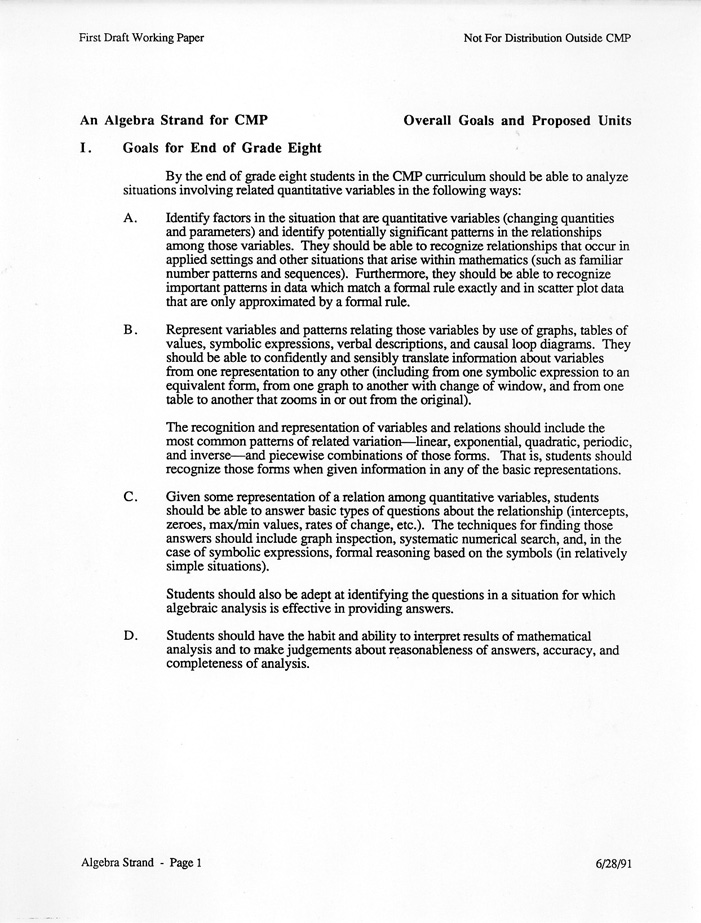
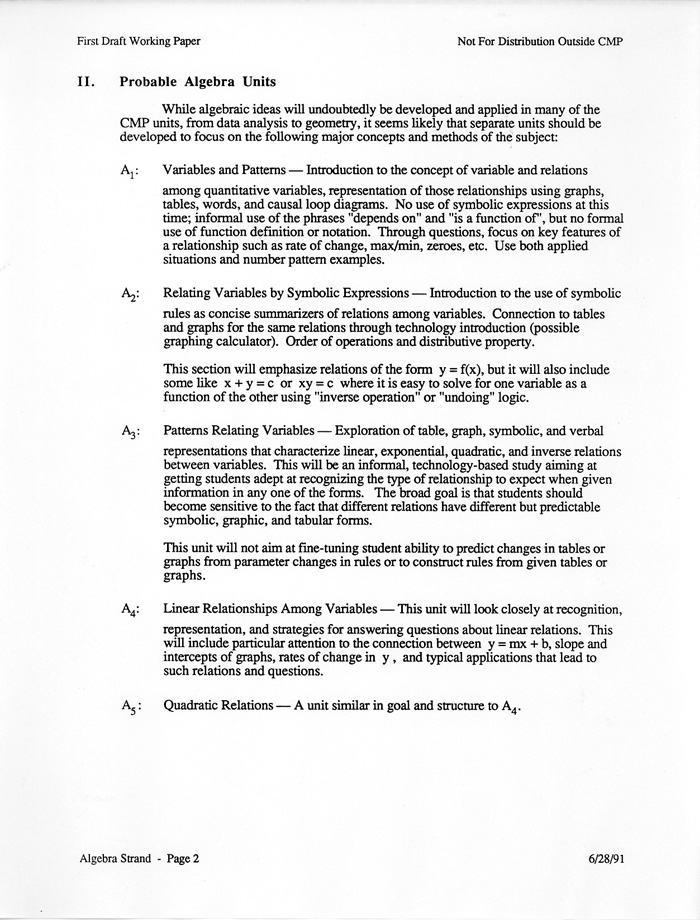
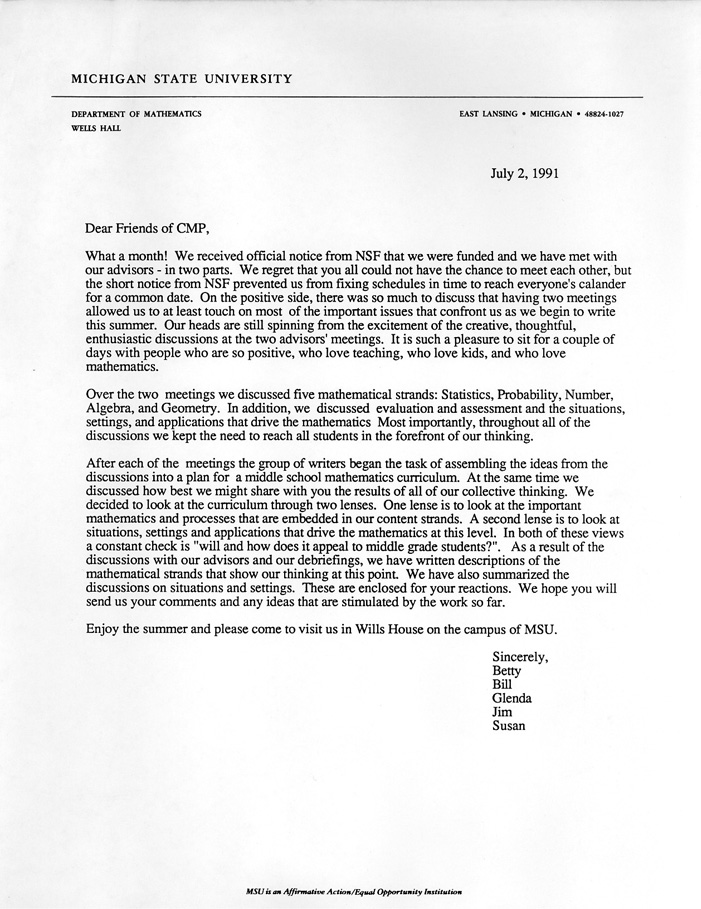

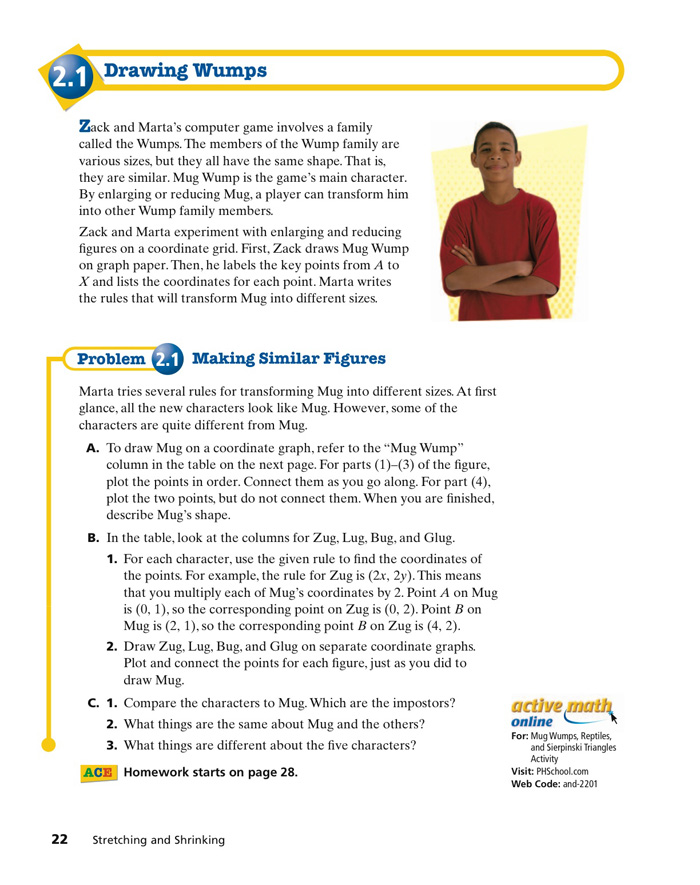
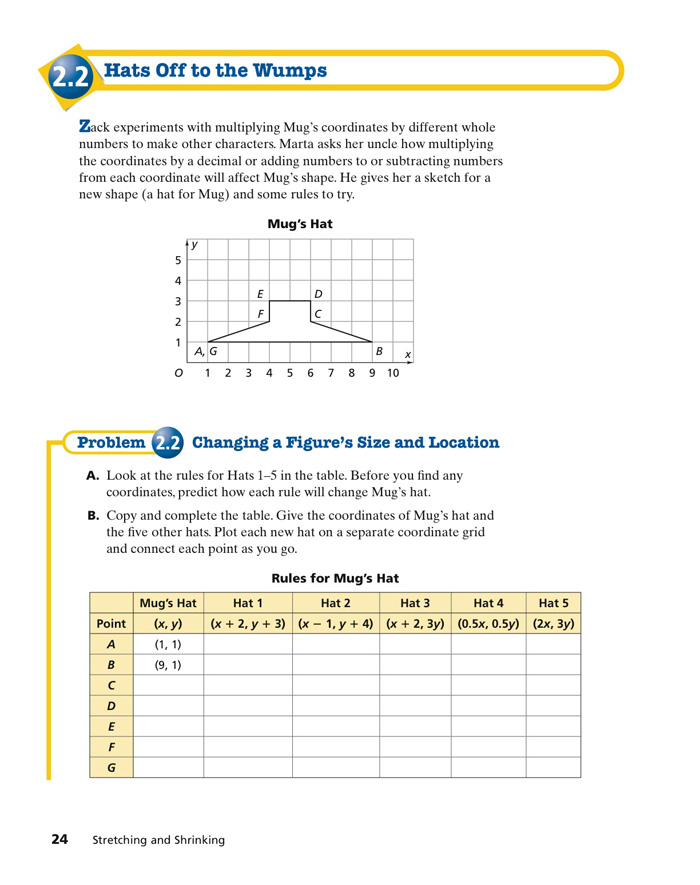
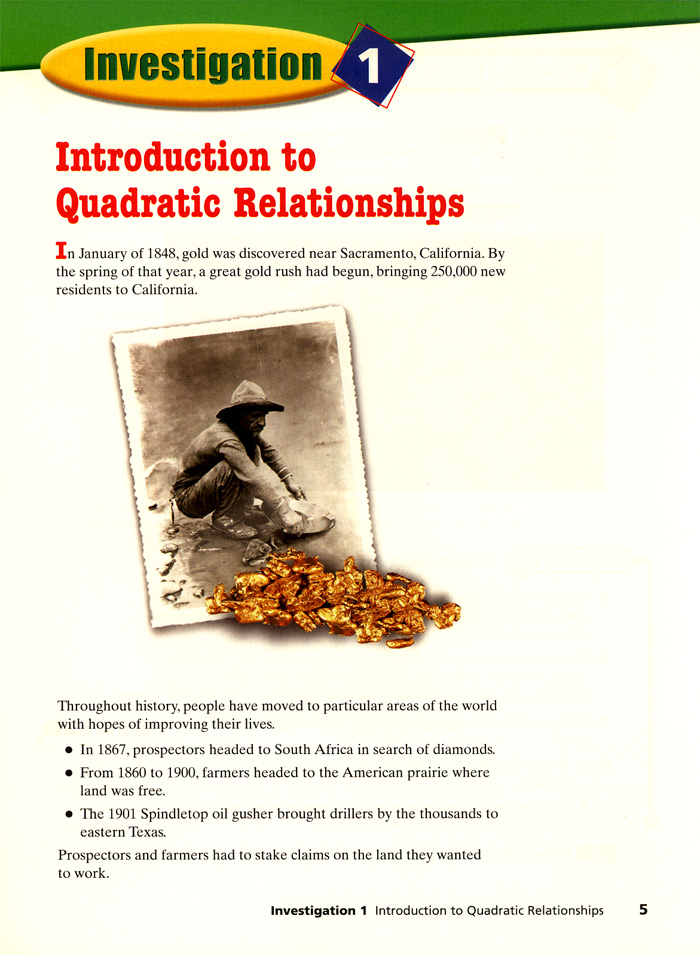
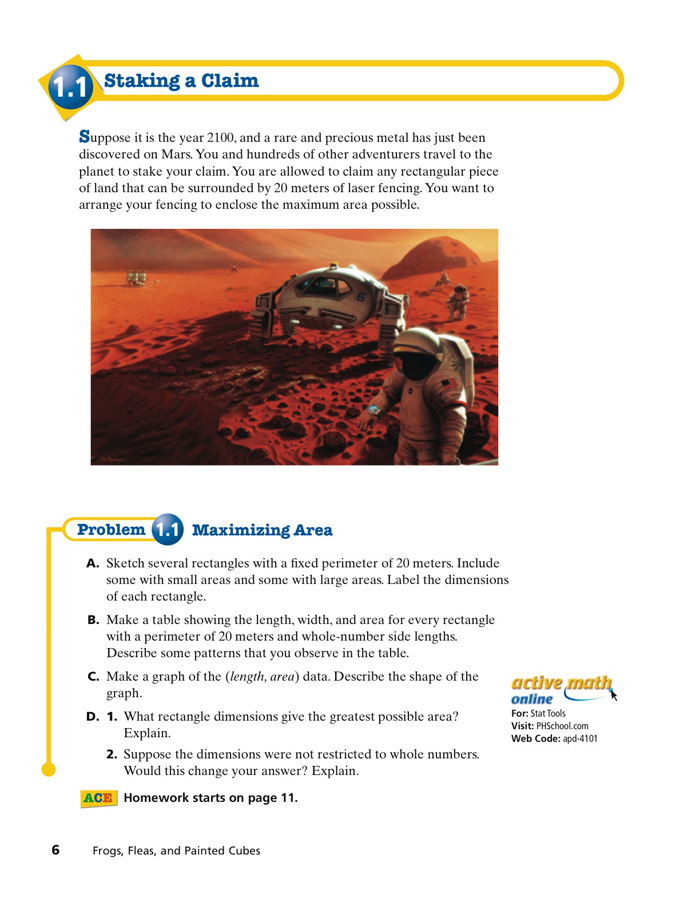
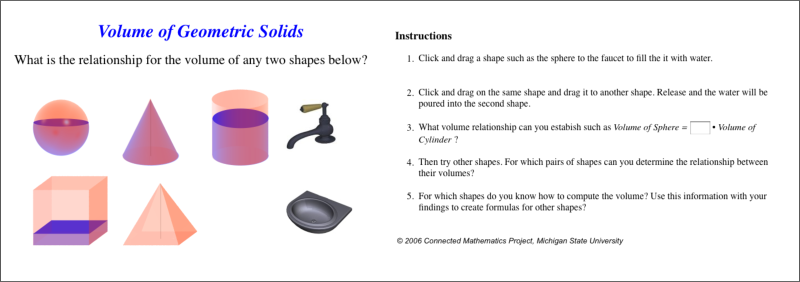 Figure
6: A computer applet for Filling and Wrapping (live
applet available online)
Figure
6: A computer applet for Filling and Wrapping (live
applet available online)
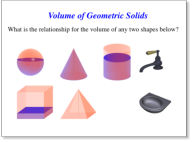 Click
above to run (Java required) Click
here for larger image
Click
above to run (Java required) Click
here for larger image Principles that Guided the Development of Connected Mathematics
4The following principles reflect both research and policy stances in mathematics education about what works to support students’ learning of important mathematics to higher levels than we had accomplished in the United States in the past. Some of the ideas from this section were taken from a paper written for an AAAS symposium on curriculum development (Phillips et al., 2001).
- An effective curriculum has coherence: it builds and connects from problem to problem, investigation to investigation, unit to unit, and grade to grade.
- Key mathematical ideas are elaborated, exemplified, and connected through the problems/tasks in an appropriate development sequence of problems/activities within a unit (see Figure 4)[3].
- Important mathematics ideas are explored through appropriate tasks in the depth necessary to allow students to make sense of the mathematics and to use their understanding to build new knowledge in subsequent units and grades.
- Both conceptual and procedural knowledge are developed with the underlying assumption that the interaction of conceptual and procedural knowledge is what produces fluency.
- Reasoning effectively in mathematics requires facility with forms of representation of ideas and the skill to move flexibly among these representations--graphic, numeric, symbolic, and verbal forms (see Figure 5).
- Classroom instruction focuses on inquiry and investigation of mathematical ideas embedded in rich problem situations.
- The information-processing capabilities of calculators and computers make fundamental changes in the way students learn mathematics and apply their knowledge in solving problems (see Figure 6).
These commitments lead to our central curriculum stance that interesting contextualized problems are a primary vehicle for engaging students in learning mathematics. We explain our rational in the following section.
Rationale for a Problem-Centered Curriculum
5Connected Mathematics is different from more conventional US curricula in that it is problem-centered. Here we elaborate what we mean by this and what the value added is for students of such a curriculum. The beginning quote from a CMP teacher sets the scene for examining the curriculum.
During that semester of student teaching, I worked with a group of 8th-grade students. There was one experience with the unit Moving Straight Ahead (Lappan, Fey, Fitzgerald, Friel, & Phillips 1998) that stands out in my memory. As an introduction to an investigation, students looked at graphs of linear relationships, one of which was of the equation y=300 + 2x. With its graph on the overhead and pointing to the y-intercept, I asked the students, “What is this?” I expected students to identify the y-intercept. Instead students said, “That is the starting or initial amount.” I slowly thought to myself, “Yeah…yeah, that’s right!” That was exactly right. Until that minute I had never made the connection between the graphical representation of the y-intercept and the situation it represented. In my mathematical experience, I have been taught to look at tables, graphs and equations. “Story problems” were rarely assigned. Even when I was asked to look at all representations, I was not pushed to understand the connections between them. For me, algebra had been about following a set of rules. It was not about understanding patterns of change and how those were reflected in other representations (Porath 2008, pp. 211-212).
The tasks or problems in which students engage form the perceptions they have about a discipline. For example, if students in a geometry course are asked to memorize definitions, they think geometry is about memorizing definitions. If students spend a majority of their mathematics time practicing paper-and-pencil computations, they come to believe that mathematics is about calculating answers to arithmetic exercises as quickly as possible. As a result they may not be able to recognize and apply these skills to other situations.
Formal mathematics begins with undefined terms, axioms, and definitions and deduces important conclusions logically from those starting points. However, mathematics itself is produced and used in a much more complex combination of exploration, experience-based intuition, and reflection. To be able to develop the skills to solve “new” problems, students need to spend significant portions of their mathematics time solving problems that require thinking, planning, reasoning, computing, connecting, proving, and evaluating. (Lappan et al., 2007). A problem-centered curriculum not only helps students to make sense of the mathematics, it also helps them to process the mathematics in a retrievable way. Learning is enhanced if it is connected to prior knowledge and more likely to be retained and applied to future learning. If mathematical tasks or situations are the driving force for developing one’s mathematical expertise, then attention to the kinds of tasks set for students is of key importance for a classroom teacher. So what makes a “good” mathematics task in a curriculum?
Criteria for a Mathematics Task
6In our work a good task is one that supports some or all of the following:
- The problem has important, useful mathematics embedded in it.
- Investigating the problem should contribute to the conceptual development of important mathematical ideas.
- Work on the problem promotes the skillful use of mathematics.
- The problem has various solutions paths or allows different decisions or positions to be taken and defended (see Figure 7).
- The mathematical content of the problem should build on and connect to other important mathematical ideas.
- The problem requires higher-level thinking, reasoning, and problem solving.
- The problem should engage students and encourage classroom discourse (see Figure 8).
- The problem creates an opportunity for the teacher to assess what his or her students are learning and where they are experiencing difficulty.
With these ideas about what constitutes good mathematical tasks in mind we turn to another aspect of learning mathematics that was of concern to us in developing a three year sequence of materials—developing reasoning and understanding of concepts and related skills and algorithms.
 Figure
7: Student work from Comparing and Scaling in CMP 1 (sample) (A
longer extract is available online) View
full extract (7 pages)
Figure
7: Student work from Comparing and Scaling in CMP 1 (sample) (A
longer extract is available online) View
full extract (7 pages) 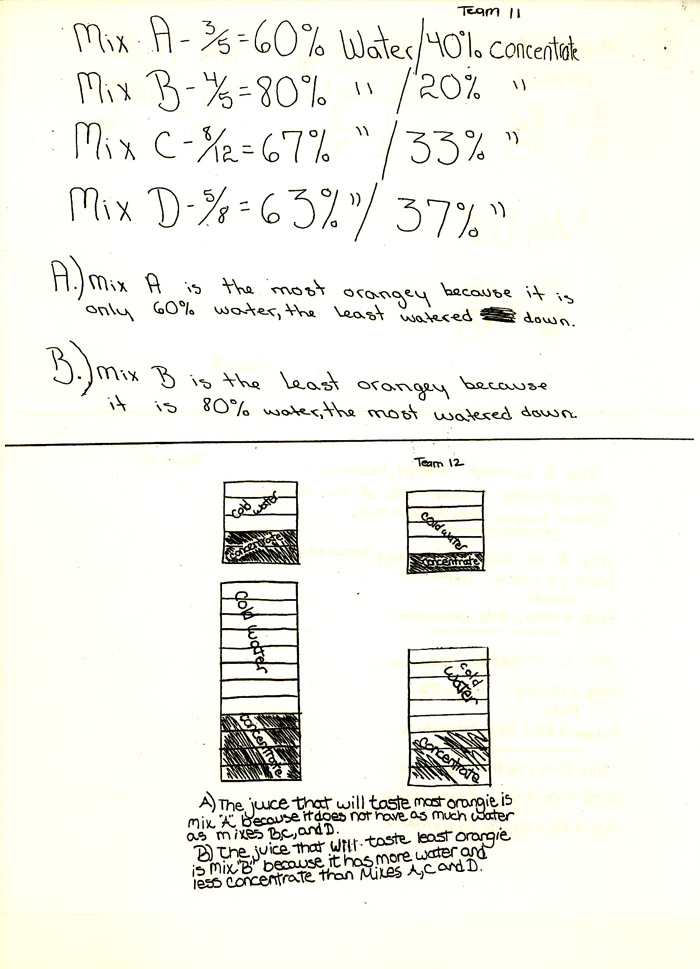
Developing Mathematical Fluency
7Students need to practice using newly learned mathematics concepts, ideas and procedures to reach a level of fluency that allows them to ‘think’ with the ideas in new situations. The following principles relate to our review of mathematical fluency.
- Immediate practice is related to the situations in which the ideas have been developed and learned.
- Continued practice uses reasoning, skill, and procedures in situations that connect to ideas that students have already encountered (see Figure 8 and Figure 9).
- Students use the ideas and skills in situations that extend beyond familiar situations.
- Practice is distributed over time to allow ideas, concepts and procedures to reach a level of fluency of use in familiar and unfamiliar situations and to allow connections to be made to other concepts and procedures (see Figure 10).
- Students learn how to make judgments about what operation or combination of operations or representations is useful in a given situation, as well as, become skillful at carrying out the needed computation(s); knowing how to, but not when to, is insufficient.
Students reflect on what they are learning, how the ideas fit together, and how to make judgments about what is helpful in which kinds of situations.
A Curriculum for Teachers and Students
8 Jerome Bruner in The Process of Education (Bruner
1977, p.xv) wrote,
If it (new curriculum) cannot change, move, perturb, inform teachers, it will have no effect on those they teach. It must first and foremost be a curriculum for teachers. If it has any effect on pupils, it will have it by virtue of having an effect on teachers.
If students’ development of deep, connected mathematical understanding and skill is the primary goal, then the ways in which students engage with mathematics and the instructional practices of the teacher must support this goal. We have taken a stand that curriculum and instruction are not distinct. The circumstances in which students learn affects what is learned. The “what to teach” and the “how to teach it” are inextricably linked. The principles that guided us in the development of the materials for students provide a way of raising issues and questions about what kind of teaching and learning is implicit in these stances.
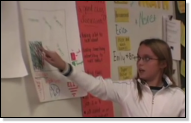 Click
to play (needs Flash Player) View
the task
Click
to play (needs Flash Player) View
the task Goals for Student Engagement
9Students develop deep understanding of mathematical concepts, skills, procedures, and processes through:
- Solving problems;
- Observing patterns and relationships among variables in a situation:
- Conjecturing, testing, discussing, verbalizing, and generalizing these patterns (see Figure 11);
- Discovering salient mathematical features of patterns and relationships and abstracting the underlying mathematical concepts, processes, and relationships;
- Developing a mathematical language for representing and communicating ideas; and
- Making sense of and connecting mathematics abstracted from their experiences.
Taking this stance on how students learn mathematics leads immediately to the need to examine what teaching practices will support such engagement. The development of materials was guided by key instructional themes. For example, classroom instruction focuses on inquiry around investigations of mathematical ideas embedded in rich problem situations. These themes are tied to content and process goals, but point more directly to the nature of classroom discourse needed to support the growth of student understanding and skill. Collectively, our stances on curriculum, teaching and learning indicate how the philosophy of CMP is compatible with major shifts in teaching and learning mathematics as described by the NCTM in the Professional Standards for Teaching Mathematics (NCTM, 1991) and in the Principles and Standards for School Mathematics (NCTM, 2000).
With these stances clarifying and guiding our intentions, we set out to develop the three-year middle school curriculum (see Figure 12). As is the case with any curriculum development effort, we faced issues and challenges that had to be resolved as we wrote units and trialed them in schools. The following is an articulation of some of these issues and challenges.
Issues and Challenges Faced in Developing the Curriculum
10As we set out to write a complete connected curriculum for grades, 6, 7, and 8, the following issues quickly surfaced and needed resolution:
- Identifying the important ideas and their related concepts and procedures;
- Designing a sequence of tasks to develop understanding of the idea;
- Organizing the sequences into coherent, connected curriculum;
- Balancing open and closed tasks;
- Making effective transitions among representations and generalizations;
- Addressing student difficulties and ill-formed conceptions;
- Deciding when to go for closure of an idea or algorithm;
- Staying with an idea long enough for long-term retention;
- Balancing skill and concept development;
- Determining the kinds of practice and reflection needed to ensure a desired degree of automaticity with algorithms and reasoning;
- Writing for both students and teachers; and
- Meeting the needs of all fifty states and diverse learners.
Examples of Resolving Issues
11Our decision about the openness of a problem was generally based on classroom experience. We considered whether the time required to develop the idea fully was time well spent; whether students could grasp the mathematical subtlety of the ideas; and whether students were reaching useful closure on the mathematical ideas. As an example, the first problem task in Investigation 1 of Bits and Pieces I from CMP 1 is very open. It was meant as a task that allowed teachers to assess what students know coming into the unit (See Figure 13a).
However, during the revision of CMP 1 we found that teachers were spending too much time attending to things that were not directly related to the mathematics such as writing clever, colorful reports about fundraising. Consequently in CMP 2, the problem was revised to provide more focus on the important mathematics, but at the same time keep the spirit of exploring, reasoning, and conjecturing that is important for the development of understanding (see Figure 13b).
Determining how long to stay with an idea so that future ideas can build off it was an issue. For example, in the 8th grade unit, Say It With Symbols, solving complex linear equations in one unknown was a goal. During the field-testing, teachers reported that students were having difficulty solving the problems. After extensive discussion and classroom observations we found that students did not have a deep understanding of some important aspects of integers needed to solve the problem. Consequently, we went back to strengthen the 7th grade unit on integers, Accentuate the Negative.
 Figure
13a: Problem 1.1 from Bits and Pieces II, CMP 1
Figure
13a: Problem 1.1 from Bits and Pieces II, CMP 1 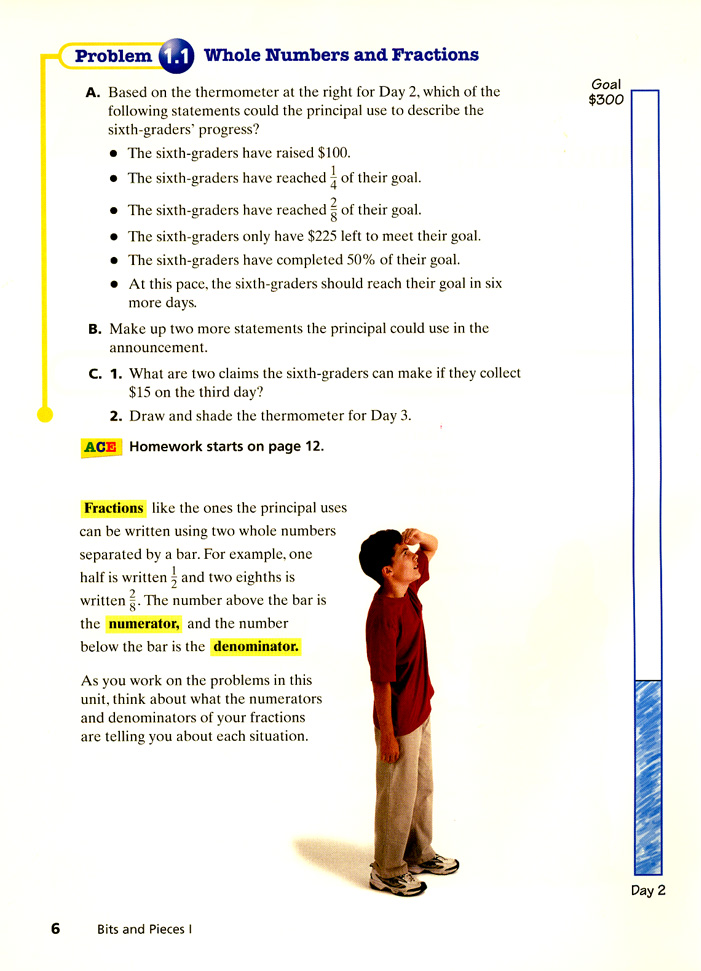 Figure
13b: Problem 1.1 from Bits and Pieces II, CMP 2
Figure
13b: Problem 1.1 from Bits and Pieces II, CMP 2 As we developed the curriculum, we believed that student writing and explaining would help students clarify their thinking and understanding. In the early drafts of the trial material, we had students writing and explaining constantly! The field test teachers were overwhelmed with the demands of so much writing. It became clear that when students write, there should be a good mathematical reason for that writing; there should be ideas to pull together, clarify, and record for future reference. Out of our struggles with writing prompts, a feature that has become a real strength of the materials for teachers and students evolved. At the end of each collection of related problems there is a mathematical reflection (See Figure 14). This is a set of questions designed to help students reflect on what has been learned, why is it important, when is it useful, and how it fits in with prior knowledge. The questions in the mathematical reflections point to the big ideas and how they fit together (abstracting and connecting); they point to skills (how-tos); they point to decisions to be made and how one makes them (when-tos); they raise issues about how these problems are similar to and different than problems encountered earlier (connecting, discriminating, and elaborating); and finally, they point toward questions to ask in similar situations (questioning habits). Each unit contains four to six investigations, each ending in a mathematical reflection that read by themselves tells a mathematical story about the unit, thus serving as a guide for the teacher and students. Student journals in which they write these reflections become a story of their own mathematical progress (see Figure 15).
Materials Development
12Through extensive field-testing, evaluating and revising we developed eight units with rational numbers as a major theme for 6th grade, proportional reasoning as a major theme for 7th grade, and patterns, functions and algebra as a major theme for 8th grade.
Each CMP unit is centered on an important mathematical idea or cluster of related ideas. A unit consists of two to five investigations, each containing two to five problems for the class to explore. Each investigation ends with a set of problems called Applications, Connections, and Extensions (ACE) that provide practice with the applications of key ideas and a Mathematical Reflections that help the class examine their progress toward understanding the big ideas. Each unit is accompanied by an assessment package and a teacher guide that provide support for the teacher to plan, teach, assess and reflect on student learning.
The Teaching Model
13The problem-centered curriculum we developed requires that the teacher possesses a broad view of mathematics and mathematical goals as articulated in the NRC volume Adding It Up (NRC 2001) and a deeper knowledge of pedagogy to support ‘inquiry’. If students are to have an opportunity to engage in learning mathematics in ways that promote the five mathematical fluencies articulate in Adding It Up, teachers need support in changing their classroom practices.
For over three decades, we have been experimenting with ways to help teachers think about problem-centered teaching. As we developed the student materials and the supporting teacher materials, we took into account the demands of problem-centered teaching. Teachers need help with both the mathematical and pedagogical demands of the curriculum. We developed an instructional model that provides a lesson-planning template for the teacher in three phases—launching, exploring, and summarizing.
During the first phase, the teacher launches the investigation with the whole class by setting the context for the problem. This involves making sure the students understand the setting or situation in which the problem is posed. More importantly, the problem task must be launched in such a way that the mathematical context and challenge are clear. The teacher is helped in the teacher materials to consider the following: What mathematical question is, or can be, asked in this situation? What are students expected to do? How are they expected to record and report their work? Will they be working individually, in pairs, or groups? What tools are available that might be helpful? This is also the time when, if necessary, the teacher anticipates what students will need and, if needed, introduces new ideas, clarifies definitions, reviews needed mathematical ideas that were developed earlier, and connects the problem to students’ prior knowledge. Launching tasks in such a way that the challenge of the task is left intact, even though students are given a clear picture of what is expected, is critical. It is easy to tell too much and lower the challenge of the task to something fairly routine.
After the task is launched, students explore the task as the teacher circulates, asking focusing questions when a student or group is struggling and extending questions when students have solved the problem but have not generalized or have not extended the problem as far as possible. The teacher takes stock of who is understanding what and who needs help; who has a strategy, generalization, or interesting way of explaining the problem solution that needs to be shared in the summary; and who has a good idea that needs to be shared but is not yet a complete solution. At times an incorrect solution provides a productive class learning opportunity.
The final phase of the instructional model is the summary. This is the most important and, perhaps, the hardest phase to do well. Here the students and the teacher work together to make the mathematics of the problem more explicit, to generalize certain situations, to abstract useful mathematical ideas, processes, and concepts, to make connections, and to foreshadow mathematics that is yet to be studied. This is also the phase of the lesson where teachers can do formative assessments to gather the data needed to plan the next lesson.
With this instructional model in mind, we have written into the teacher materials suggestions for teachers about how to plan for instruction. What we have provided is not meant to be an algorithm, but to provide teachers with ways of thinking about their planning and their enactment of lessons. We imagine ourselves as sitting on the shoulder of a teacher and having a conversation about a set of possible ways to engage the students in a lesson (see Figure 16).
For each lesson, we have provided examples of questions that can be used to elicit student thinking, to push students’ thinking toward deeper mathematical insights, and questions that can be used at the end of a class as a quick formative assessment to help in planning for the next lesson. We have written mathematical background essays for each unit to help teachers know the mathematics goals of the unit and the forms of mathematical representation that is used in the unit (see Figure 17). Too often teachers plan for and teach lessons by turning a page to see what comes next . Our goal is for teachers to have a more robust view of what students have an opportunity to learn and how teachers can support them in their learning from each lesson.
Developing a Classroom Climate
14As we have suggested in the prior section, the materials, for both student and teacher, are designed in ways that help students and teachers build different patterns of interaction and discourse in the classroom. The materials support a teacher and his/her students in building a community of learners who work together to make sense of the mathematics. We do this through the tasks provided, the justification that students are asked to provide on a regular basis, the opportunities for students to talk about and write about their ideas, and the help for the teacher in using alternative forms of assessment and a problem–centered instructional model in the classroom. Ideas from many teachers are included in the teaching materials to help others establish an environment that supports students taking more responsibility for making sense of mathematics. Changing the patterns of mathematics discourse in the classroom is hard for both teachers and students. Teachers may be frustrated in moving from a rule-based curriculum to a problem-centered one. Teachers and parents do not like to see their students struggle—yet learning without struggle is unlikely. Students may not be happy with their past experiences with mathematics, yet still may resist any attempts of the teacher to change the culture of the classroom. Students may be used to a mathematics classroom where little is required of them beyond practicing the idea that was illustrated by the teacher in the first part of the lesson. This means that the hard work of changing students and parent’s view of what mathematics can become for students through investigation of engaging and demanding tasks is a challenge for the teacher. Students now are required to think and reason—and above all, learn to persist in thinking through a situation and finding ways to use what they know to find a solution (see Figure 18). In a classroom with a teacher committed to mathematical discourse around interesting mathematical tasks, students, resistant in September, can be fully engaged by November. The role of the teacher in the classroom is a key factor in whether this transformation happens or not (see Figure 19).
Writing, Field Testing, Advisory Board, and Collaborating Teachers
15We began the writing process, creating first drafts of units of mathematics around each of the central mathematical themes for a grade level. Simultaneously, we invited schools to apply to be a trial site for the materials. From the applications we identified school sites that were representative of US demographics— 24 schools for the first edition of CMP and 25 schools for the second edition of CMP. We had a member of our formative assessment team at each of the initial CMP 1 sites and a mathematics coordinator at each of the CMP 2 sites. These colleagues visited classrooms, had meetings for feedback from the teachers and wrote reports feeding information to the development team. We had teachers from each site visit our campus office to interact with the authors and the advisory board.
Our process of development and trialing helped to produce materials that are cohesive and effectively sequenced. For example, the table of contents for the Covering and Surrounding Units for CMP 1 and CMP 2, reflect the knowledge gained from listening to teachers and leaders of CMP 1. In trying to be more efficient, we moved the second investigation on fixed area and fixed perimeter to the end of the unit. During the field testing of this version in CMP 2, teachers quickly reported that students' understanding of area and perimeter was not as robust as it was when this investigation came earlier. As a result it was moved back to the 2nd investigation. The interaction of area and perimeter in this investigation was key to the development of students understanding of area and perimeter. We also learned from the field that the exploration of irregular figures came too early and caused confusion. After a series of trials, irregular figures found a natural fit as a lead into the development of area and circumference of a circle (see Figure 20).

The diagram shows the design and development cycle we used for both CMP 1 and CMP 2 (see Figure 21).
Even though it took classroom trials, observations, discussions, revisions, more trials, research and reflections to resolve issues that arose into a coherent curriculum, our initial analysis of overarching goals remained sound. However, our notions of what we could expect to teach in one year, in a curriculum based on bigger problems, did change. Sufficient instructional time was needed to foster deep understanding of the big ideas. A problem was that school districts varied in the length of time allocated for instruction in mathematics. Some schools had as little as 37 minutes a day for mathematics. Others had 50 to 70 minutes allocated to mathematics each day. With a problem centered curriculum, completing a lesson in only 37 minutes was a challenge. Not completing all phases of the lesson in a class period meant that students and the teacher had to recreate the situations the next day in order to benefit from the class discussion in the summary. This continues to be a problem as teachers who were quite comfortable demonstrating how to do a particular computation procedure are asked to open their classrooms to exploration and discussions. To make progress on changing the classroom structure, we had to consider our work as creating a curriculum for both teachers and for students while cognizant of the differing situations in which teachers work. In the following section we give a glimpse of how our interaction with schools and teachers influenced the materials.
CMP: A Curriculum Co-Developed with Teachers and Students
16Developing a curriculum with a complex set of interrelated goals takes time and input from many people. To summarize the discussion above, our work was based on a set of deep commitments we, as authors, had about what would constitute a more powerful way to engage students in making sense of mathematics. Our advisory boards took an active role in reading and critiquing units in their various iterations. In order to enact our development principles, we found that three full years of field trials for each grade in schools was essential. This feedback from teachers and students is the key element in the success of the Connected Mathematics Project materials. The final materials comprised the ideas that stood the test of time in classrooms. Over 200 teachers in 49 school sites around the country (and their thousands of students) are a significant part of the team of professionals that made these materials happen. The scenarios of teacher and student interactions with the materials became the most compelling parts of the teacher guides.
We have by all indicators developed a curriculum through which teachers and students have learned mathematics. We have also produced a curriculum that challenges ’standard’ formats and goals for students’ engagement in mathematics. It challenges teachers to create very different kinds of classroom environments. It values mathematics beyond the learning of computational algorithms. CMP is still controversial and at the same time, has become a curriculum that mathematics education and policy researchers find interesting to study. A substantial number of research studies have been carried out in CMP classrooms during the 14 years since the first iteration was available to the field. These studies have helped the field understand the conditions under which CMP and other ‘reform’ curricula can support dramatic changes in what students know and are able to do in mathematics (see Eddy, R.M., Berry, T., 2008 and the CMP Website). These studies have also looked at teachers learning from the curriculum and confirmed that teachers learn mathematics from teaching the curriculum. CMP use in teacher education programs continues to grow. While we are always thinking of things we would like to do in a next iteration, we do take time to reflect on what we have learned and what the field has learned from CMP. The bottom line is that the struggle to develop such a curriculum has been worth every ounce of energy put into it. After 20 years of curriculum work we are still having ideas!
Challenges We Face after 20 Years of Curriculum Work
17We live in a world in which mathematics is required in nearly every job—certainly the ones that provide a decent living for people. This means that we need to raise the mathematical proficiencies of all of our students to new heights.
We need to set new expectations for schools and for the ways teachers work together. The message needs to be that teachers need a broader curriculum view than they have at present. A third grade teacher needs to know the mathematics of grades two and four in his or her school. The attitude that I am a kindergarten teacher so why should I learn all this stuff sells our students short. Building a teaching community in which interaction, common planning and assessments, cross-disciplinary interactions, and reflecting are the norm is needed to help teachers make what amounts to a substantive culture change in their schools.
Consistent, focused, continuing, high quality professional development opportunities are needed. Expecting teachers to work together on planning and debriefing lessons should be the norm in schools. This means that time for such activity is built into the school day. Yes, teachers should be held accountable for student learning. But school administrations, school boards and the community are responsible for building a climate in which teachers are expected to be and are given opportunities to become the instructional voices for the disciplinary knowledge and support students need to thrive. Currently, in many schools, the role of a teacher has been undermined to the point that teachers are leaving the profession, or even worse, choosing to give students experiences with particular skills in isolation from each other in order to ’cover’ what is being tested on the state exam. We know that teachers in the US are under great stress from parents. We also know that the future success of students depends on what opportunities and support that are provided by the teacher and the school environment. Curriculum materials are a central player in those opportunities.
For the second time in our work lives, mathematicians in the US have become active players in mathematics education. Being realistic, mathematics educators and mathematicians have very different commitments to the enterprise and these interactions are not always easy. However, this interaction between mathematicians and mathematics educators is one of the best hopes for improving mathematics education in the 21st century as difficult (and as stimulating) as these interactions are at times.
Summary
18From the authors’ perspectives, our hope was to develop materials that play out deeply held beliefs and firmly grounded theories about what mathematics is important for students to learn and how they should learn it. We hope that we have been a part of helping to challenge and change the curriculum landscape of our country.
We have tried to give you some insight into the ideas and commitments that have driven our team for over 25 years. We have done this in the spirit of opening up a discussion of which of the ideas and commitments of our team are useful to other curriculum developers, now and in future, perhaps better, times. The huge movement in standards based mathematics to more contextualized problems may not survive due to the current US focus on individual grade level state standards, with high stakes testing at every grade level. But as surely as the sun rises each day, another round of focus on the kinds of classroom interactions around mathematics portrayed in our goals will occur. We hope that our articulation of ways to look at what can drive the development of effective curriculum materials will be of use to others. Remember the stance of W.W. Sawyer (Sawyer, 2004, p.110):
The depressing thing about arithmetic badly taught is that it destroys a child's intellect and, to some extent, his/her integrity. Before they are taught arithmetic, children will not give their assent to utter nonsense; afterwards they will. Instead of looking at things and thinking about them, they will make wild guesses in the hopes of pleasing the teacher.
W. W. Sawyer (British mathematician)
The teaching and learning of mathematics can open the eyes of our students to the beauty and wonder of our amazing physical and intellectual world. Done badly, it can also kill the spirit of a child, make them feel stupid, and forever condemn them to a physical and intellectual world that stimulates no curiosity. Curriculum always has and always will have a major role to play in determining students’ opportunities to learn.
References
19Bruner, Jerome. (1992). Science education and teachers: A Karplus lecture. Journal of Science Education and Technology; 1(1), 5-12.
Connected Mathematics Project (2009) Website, Michigan State University.
URL: http://connectedmath.msu.edu/
Eddy, R.M., Berry, T., et. al. (2008) The Effects of Connected Mathematics
Project 2 on Student Performance: Randomized Control Trial, Claremont
Graduate University, Claremont CA, USA.
Retrieved from: http://connectedmath.msu.edu/pnd/cmp2_efficacy_study_2007-08.pdf (November
2009)
Fey, J. T., Fitzgerald, W. M., Friel, S. N., & Lappan, G. (2006). Connected Mathematics Project: Research and evaluation summary: Prentice Hall.
Lappan, G., Fey, J., Fitzgerald, W., Friel, S., Phillips, E. D. (1998). Connected Mathematics. Menlo Park: Dale Seymour.
Lappan, G., Fey, J., Fitzgerald, W., Friel, S., Phillips, E. D. (2006). Connected Mathematics 2. Boston: Pearson-Prentice Hall.
Lappan, G., Fey, J. T., Fitzgerald, W. M., Friel, S. N., & Phillips, E. D. (2004). Getting to know Connected Mathematics: An implementation Guide: Pearson Prentice Hall.
Lappan, G., Phillips, E. D., Fey, J. T. (2007). The case of connected mathematics in Perspectives on the design and development of school mathematics curricula. C. R. Hirsch (Ed.). Reston, VA: NCTM.
National Academy of Sciences. (1983). A Nation and Risk: The Imparative for Educational Risk . Washington DC: NAS.
National Council of Teachers of Mathematics. (1989). Curriculum and evaluation standards for school mathematics - Executive Summary. Reston, VA: NCTM.
National Council of Teachers of Mathematics. (1991). Professional standards for teaching mathematics. Reston, VA: National Council of Teachers of Mathematics.
National Council of Teachers of Mathematics. (2000). Principles and standards for school mathematics. Reston, VA: Author.
National Council of Teachers of Mathematics. (2003). A Research Companion to Priciples and Standards for School Mathematics J. Kilpatrick, W. Martin, & D. Schifter (Eds). Reston. VA: NCTM.
National Council of Teachers of Mathematics. (2007). Perspectives on the design and development of school mathematics Curricula. C. R. Hirsch (Ed.). Reston, VA: NCTM.
National Research Council. (2001). Adding it up: Helping children learn mathematics. J. Kilpatrick, J. Swafford, & B. Findell (Eds.) Washington, DC: National Academy Press.
Phillips, E., Fey, J., Friel, S., & Lappan, G. (2001). Developing Coherent, High Quality Curricula: The Case of the Connected Mathematics Project. American Association for the Advancement of Science (AAAS).
Porath, Jane, P. (2008). A story of teacher growth. In M. R. Meyer and C. W. Langrall (Eds.), A decade of middle school mathematics curriculum implementation. Charlotte NC: Information Age Publishing, Inc.
Sawyer, W. W. (2004). Personal communication in Teaching Middle School Mathematics. D. K. Brumbugh, E. Ortiz, R. H. Gresham. Lawrence Erlbaum Associates (2006). p. 110.
Footnotes
20[1] MGMP Materials are available from Pearson
[2] This section (The Case of Connected Mathematics) is based on a chapter in the book Perpectives on the Design and Development of School Mathematics Curriculum, published by NCTM in 2007.
[3] The units shown in Figure 4 and onward are from Connected Mathematics or Connected Mathematics 2.
About the Authors
21Glenda Lappan's research and development interests are in the connected areas of students’ learning of mathematics and mathematics teacher professional development. She has served as Program Director for Teacher Preparation at the National Science Foundation; President of the National Council of Teachers of Mathematics; Co-Director of Connected Mathematics Project; Chair of the grades 5–8 development of NCTM Curriculum and Evaluation Standards for School Mathematics; Chair of NCTM Professional Standards for Teaching Mathematics; on the National Education Research Policy and Priorities Board; Advisory Board for Education and Human Resources at NSF; Vice Chair of the Mathematical Science Education Board of the NRC; and Chair of the Conference Board of the Mathematical Sciences. She has received a University Distinguished Faculty Award from Michigan State University, the Michigan Council of Teachers of Mathematics Lifetime Achievement Award, the Association of Women in Mathematics Louise Hay Award in Mathematics Education, the Meritorious Faculty award from the MSU College of Natural Sciences at MSU, the George Eastman Medal for Excellence from the University of Rochester, the Glenn Gilbert Award from the National Council of Supervisors of Mathematics and the Outstanding Alumni Award from the University of Georgia.
Elizabeth Phillips' on-going interests are in the teaching and learning of mathematics with a special interest in teaching and learning algebra. She conducts numerous workshops for teachers, gives speeches, and is a consultant on mathematics-education at the local, state, and national levels. She is the author of numerous papers and books. Most recently she is a co-author of The Connected Mathematics Project (CMP 1), a five-year NSF-funded project to write, test, and implement a complete mathematics curriculum for the middle grades (1991–1997) and CMP 2 which was also funded by NSF (2000-2006) to revise the CMP curriculum and to develop professional development materials to support the CMP curriculum. She is also a principal investigator for a NSF funded project, the Center to Study Mathematics Curriculum (CSMC 2004-2009). This is a partnership consisting of Michigan State University, The University of Missouri, and Western Michigan to promote leadership and research on all aspects of curriculum, in particular, as curriculum relates to student and teacher knowledge. She is a co- editor of an upcoming NCTM publication “The Best of the Middle School Addenda Series”. Her current work is developing professional development materials using classroom videos to support the implementation of CMP.
Elizabeth Phillips and Glenda Lappan were joint winners of the 2008 ISDDE Prize, in recognition of their work on Connected Mathematics.
The authors wish to thank our undergraduate assistant, Bradley Corlett, for his technical assistance with the paper.
